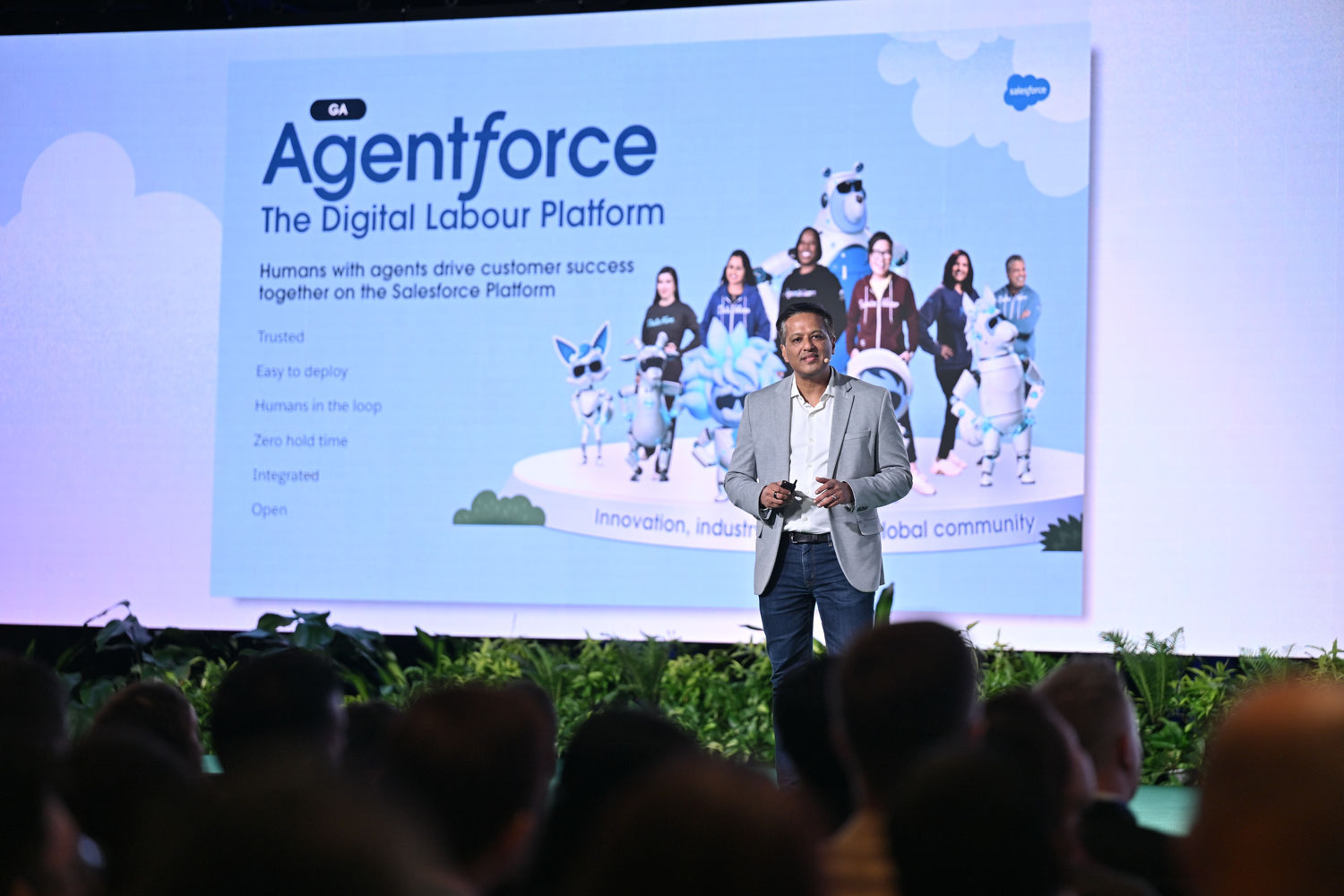Integrating human and artificial intelligence (AI) is on track to become a standard operating procedure in workplaces across Asia Pacific. Human resource (HR) leaders in the region expect a 450% increase in AI agent adoption by 2027, up from just 10% today, according to Salesforce. These AI agents, which can take autonomous actions, are projected to boost productivity by 27% and reduce labour costs by 25%.
“Any service-oriented organisation that has high customer service costs and intense manual labour work is interested in using AI agents, including telcos, banks, and healthcare institutions,” says Sujith Abraham, Salesforce’s senior vice-president and general manager for Asean, in an interview with The Edge Singapore.
He adds that AI agents are particularly effective at scaling workforces. For example, AI agents can fast-track onboarding and equip new hires (such as property agents or customer service officers) with real-time and accurate information to help them handle client inquiries more efficiently and ease the burden on stretched teams.
Scaling the workforce is crucial for companies operating in fast-growing markets. “Some of the markets in this region have large populations, so hiring people fast enough to serve all those consumers is challenging. If an organisation can drive greater productivity levels with the same amount of human labour at a fraction of the cost, its employees can handle more work and its labour costs will come down. [Perhaps more importantly,] it also allows the organisation to redeploy some of their employees into higher-value roles, which benefits the top line too,” he says.
While AI agents are becoming embedded in operations, they will not replace humans entirely. According to the Salesforce study, HR leaders believe most employees will remain in their current roles, working alongside AI. However, 21% are likely to be redeployed to new roles or teams, an approach that 84% of HR leaders view as more cost-effective than external hiring.
Redeploying existing staff also helps preserve institutional knowledge, which can be critical when redesigning jobs to accommodate a blended human-AI workforce, says Abraham.
See also: From doubt to influence: How are women in tech revolutionising the future?
An experienced frontline employee can highlight operational pain points that others might miss, and those insights could help reimagine [parts of] the customer journey. Institutional knowledge is super valuable, and providing [experienced human employees] with AI agents can empower them to dream about what could be different.
An experienced frontline employee can highlight operational pain points that others might miss, and those insights could help reimagine [parts of] the customer journey. Institutional knowledge is super valuable, and providing [experienced human employees] with AI agents can empower them to dream about what could be different.Sujith Abraham, senior vice-president and general manager for Asean, Salesforce
See also: Keys to moving from AI dust to game changers
Top-down approach
Effectively deploying agentic AI at scale for a human-AI workforce depends on leadership, not just IT, asserts Lisa Bouari, regional AI leader for Oceania at EY. “Such moves ideally need to be a top-down imperative, driven either from the C-suite, the board, or senior business stakeholders. If the AI deployment is only a technical implementation that is not in line with the strategic imperative of a business, it can never scale beyond a proof of concept because there’s no funding and change management to support it. I call it a failed science experiment.”
To that end, some organisations have appointed chief AI officers to define and guide their AI strategy. Others are forming cross-functional AI steering committees that bring together business, data, cybersecurity, IT, and risk leaders. “Often, the central AI body or steering committee doesn’t necessarily build use cases. Instead, it focuses on standing up AI platforms with guardrails to enable business units to deploy their AI applications,” Bouari explains.
She also observes that more companies are establishing “AI factories” or dedicated teams tasked with prioritising and pipelining AI use cases, justifying investment, and tracking outcomes post-deployment.
Getting buy-in from employees, especially those in non-IT teams, calls for a culture of experimentation. “Giving employees hands-on experience with AI tools is a good way for them to gain the necessary skills while finding ways where AI can help them be more effective at their job,” says Bouari.
However, experimentation must be accompanied by upskilling. Bouari likens today’s transition to AI agents to the rollout of personal computers (PC), which requires the same deliberate investment in workforce capabilities.
Organisations didn’t just give everyone a PC and think they would just figure it out. People had to be trained. So, if companies will have agentic workforces in the future, they must ensure their human employees understand what AI agents can do and how to work with those digital assistants before investing in agentic AI tools.
To stay ahead of the latest tech trends, click here for DigitalEdge Section
Organisations didn’t just give everyone a PC and think they would just figure it out. People had to be trained. So, if companies will have agentic workforces in the future, they must ensure their human employees understand what AI agents can do and how to work with those digital assistants before investing in agentic AI tools.Lisa Bouari, regional AI leader for Oceania, EY
The role of trust
To ease concerns over job displacement, leaders and HR must collaborate with employees to redesign roles incorporating AI.
Bouari exemplifies: “At EY, we’re defining new career and skills pathways with HR and our global training teams, knowing that every employee will eventually use AI in their work, which could completely transform some of our services. It takes a transformation beyond a tech rollout to [succeed with a blended human-AI workforce].”
This approach has yet to become mainstream. Only 59% of employees globally say they have had a say in how their jobs will evolve with AI, according to the 2025 State of AI in Employee Experience study by experience management firm Qualtrics.
“In some organisations, it feels like AI is happening with people. In others, it’s happening to people. The latter tends to occur when AI initiatives are very top-down and employees feel shut out, triggering fears of job loss or reduced autonomy,” says Lauren Huntington, Qualtrics’s solution strategy leader.
Trust, she adds, is critical to enabling AI-assisted workforces and operations. Organisations can do so by clearly and openly communicating business goals to their employees. “These are the north star metrics, which should also include employee sentiment around AI [in enabling them to achieve those targets]. And if leaders say there won’t be job cuts due to AI but layoffs happen anyway, trust disappears. But if leaders are transparent about timelines and follow through on support, they build credibility with employees.”
Companies also need to close the feedback loop to reinforce trust further. Instead of conducting an annual employee survey, organisations should have regular team-level check-ins and analyse unstructured data (such as internal chat or email sentiment), so long as employees can opt out. “This is the new psychological contract. Employees are willing to share their voices and data, but only if companies act on that feedback ethically and provide safeguards like anonymity,” says Huntington.
Besides that, she sees a strong link between employee engagement and sentiment toward AI.
In highly engaged workplaces, employees tend to view AI more positively because they believe it will be used to help them. Hence, companies prioritising employee wellbeing in tech decisions will likely get more out of their AI investments.
In highly engaged workplaces, employees tend to view AI more positively because they believe it will be used to help them. Hence, companies prioritising employee wellbeing in tech decisions will likely get more out of their AI investments.Lauren Huntington, solution strategy leader, Qualtrics







